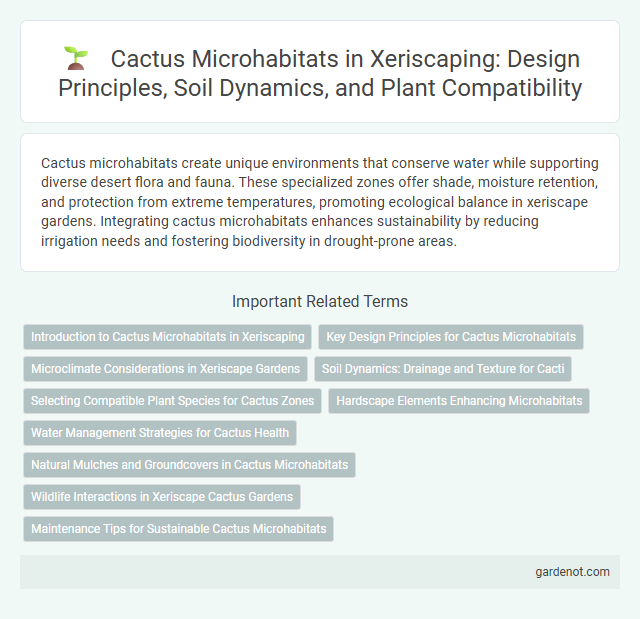Cactus microhabitats create unique environments that conserve water while supporting diverse desert flora and fauna. These specialized zones offer shade, moisture retention, and protection from extreme temperatures, promoting ecological balance in xeriscape gardens. Integrating cactus microhabitats enhances sustainability by reducing irrigation needs and fostering biodiversity in drought-prone areas.
Introduction to Cactus Microhabitats in Xeriscaping
Cactus microhabitats in xeriscaping create ideal environments by mimicking natural desert conditions, optimizing water retention and sunlight exposure. These microhabitats support diverse xerophytic species by providing shade, moisture traps, and wind protection, enhancing plant survival in arid landscapes. Implementing cactus microhabitats reduces irrigation needs and promotes sustainable, low-maintenance garden designs.
Key Design Principles for Cactus Microhabitats
Cactus microhabitats thrive in well-drained, sandy or rocky soils that mimic their natural desert environment, promoting root health and preventing waterlogged conditions. Incorporating strategic shading with larger rocks or companion plants can reduce heat stress and moisture evaporation, optimizing water use efficiency. Positioning cacti to maximize sun exposure while allowing for adequate airflow ensures robust growth and resilience against pests and diseases.
Microclimate Considerations in Xeriscape Gardens
Cacti thrive in xeriscape gardens by benefiting from their microhabitats, which create optimal microclimate conditions such as increased sunlight exposure and reduced humidity. These microclimates support water-efficient growth by minimizing evaporation and providing heat retention during cooler nights. Positioning cacti near rocks or elevated soil enhances thermal mass, further stabilizing temperature fluctuations crucial for their survival in drought-prone landscapes.
Soil Dynamics: Drainage and Texture for Cacti
Soil dynamics play a crucial role in the microhabitat of cacti, with optimal drainage and texture ensuring healthy root systems and preventing waterlogging. Well-draining sandy or gravelly soils promote aeration and reduce the risk of root rot, vital for xeriscape environments. The coarse texture helps retain minimal moisture while allowing rapid water infiltration, supporting the cactus's drought-resistant adaptations.
Selecting Compatible Plant Species for Cactus Zones
Selecting compatible plant species for cactus microhabitats involves choosing drought-tolerant, low-water-use plants such as agave, yucca, and desert wildflowers that thrive in similar arid conditions. These species enhance soil stability, provide shade to regulate temperature extremes, and promote a balanced ecosystem within xeriscape landscapes. Proper plant selection reduces irrigation needs and supports native pollinators, contributing to sustainable water conservation efforts.
Hardscape Elements Enhancing Microhabitats
Hardscape elements such as rocks, gravel, and porous pavers create essential microhabitats for cacti by providing stability, moisture retention, and temperature regulation. These materials mimic natural desert environments, allowing cacti roots to thrive in well-drained soil while reducing water evaporation. Integrating hardscape features strategically enhances microclimates that support cactus growth and biodiversity within xeriscape landscapes.
Water Management Strategies for Cactus Health
Cactus microhabitats are designed to maximize water efficiency by incorporating mulches, well-draining soils, and strategic plant spacing to reduce evaporation and retain moisture near the root zone. Deep but infrequent watering mimics natural desert rainfall patterns, promoting strong root growth and drought resilience. Integrating water-saving techniques such as drip irrigation and rainwater harvesting ensures optimal hydration while minimizing waste in xeriscape landscapes.
Natural Mulches and Groundcovers in Cactus Microhabitats
Natural mulches such as dried leaves, bark chips, and decomposed organic matter play a crucial role in cactus microhabitats by conserving soil moisture and regulating temperature fluctuations. Groundcovers like low-growing succulents and native grasses reduce soil erosion and provide shade, creating a stable microclimate that supports cactus root health. These elements enhance xeriscape sustainability by promoting water efficiency and mimicking natural desert ecosystem conditions.
Wildlife Interactions in Xeriscape Cactus Gardens
Xeriscape cactus gardens create crucial microhabitats that support diverse wildlife by offering shelter, food, and nesting sites for birds, insects, and small mammals. The spiny structure of cacti protects wildlife from predators while their flowers provide nectar for pollinators such as bees and hummingbirds. These cactus microhabitats enhance biodiversity and contribute to the ecological balance in arid landscapes by sustaining native species adapted to xeric conditions.
Maintenance Tips for Sustainable Cactus Microhabitats
Maintaining a sustainable cactus microhabitat requires minimal watering, as overwatering leads to root rot and fungal infections. Using well-draining soil composed of sandy or rocky substrates enhances aeration and mimics natural desert conditions, promoting healthy growth. Regularly removing debris and providing partial shade during intense heat reduces stress and preserves the microhabitat's delicate balance.
Cactus microhabitat Infographic

 gardenot.com
gardenot.com